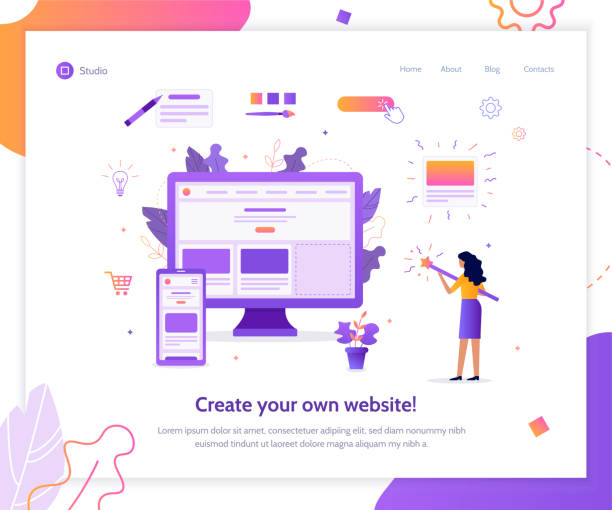Introduction to #Responsive_Web_Design and its Importance in the Current Era

In today’s digital world, where users access web content from a variety of devices including smartphones, tablets, laptops, and even smart TVs, the importance of #Responsive_Web_Design has become more evident than ever.
It is no longer possible to expect a single, fixed version of a website to provide a consistent user experience across all these devices.
#Responsive_Web_Design is a leading approach in web development that aims to provide an optimal visual and interactive experience for the user, regardless of their device’s screen size.
This approach ensures that your website automatically adjusts its layout, images, and fonts to provide the best possible display on any device.
This not only leads to an improved user experience but also plays a vital role in Search Engine Optimization (SEO).
Google and other search engines give better rankings to websites with responsive design because they offer a better mobile user experience.
This is a specialized approach that allows developers and web designers to optimize content for all platforms with a single codebase, which significantly saves time and cost.
In this article, we will delve deeper into the principles, techniques, and benefits of this new method of responsive website design.
Is your online store ready to attract maximum customers and increase sales? Rasaweb transforms your online business with modern and efficient e-commerce website design.
✅ Increased speed and improved SEO
✅ Excellent user experience on mobile and desktop⚡ Get free consultation for e-commerce website design from Rasaweb!
Basic Principles of Responsive Design and its Difference from Adaptive Design

Responsive website design is based on three key principles: Fluid Grids, Flexible Images, and Media Queries.
Fluid Grids use relative units like percentages for element widths instead of fixed pixels, allowing them to change with screen size.
Flexible Images also ensure, with specific techniques like `max-width: 100%`, that images never overflow their container and are scalable according to the available space.
The most important principle, Media Queries in CSS, allows the website to apply different styles based on device characteristics such as screen width, orientation, and resolution.
In contrast, Adaptive Web Design (AWD) takes a different approach.
Instead of a single layout fluidly adapting to any size, adaptive design provides several fixed versions of the website layout based on specific screen sizes.
When a user visits the site, the server or JavaScript identifies the screen size and displays the most suitable version of the website to them.
For example, there might be one version for desktop, one for tablet, and one for mobile.
The main and questionable content difference is that responsive website design provides a fluid and integrated experience that is adjustable across infinite screen sizes, while adaptive design offers limited, predefined options.
Both approaches have their specific advantages; responsive for flexibility and easier maintenance of a single codebase, and adaptive for more precise control over the user experience at specific breakpoints.
The choice between these two depends on project needs and available resources and is a specialized discussion in the field of User Experience (UX) optimization.
Key Techniques and Tools in Implementing Responsive Web Design

Implementing responsive website design requires familiarity with a set of techniques and tools that help developers build flexible and efficient websites.
One of the main techniques is the use of Media Queries, which was mentioned earlier.
This CSS capability allows you to apply different styles based on screen width, resolution, orientation, and other characteristics.
For example, you can change font sizes, column order, or even the display/hide of certain elements based on the device.
In addition to Media Queries, the use of relative units such as `em`, `rem`, `vw`, `vh`, and percentage (%) instead of fixed pixels is essential for creating fluid grids and scalable typography.
These units ensure that screen elements change proportionally with the device’s size and resolution.
For image management, various techniques exist, including `max-width: 100%` for simple scaling, or using `
Development tools also play an important role.
CSS frameworks like Bootstrap and Foundation greatly accelerate the responsive design process by providing flexible grid systems and pre-built components.
Browser Developer Tools in Chrome, Firefox, and other browsers are also crucial for simulating different screen sizes and testing website responsiveness.
These tools provide explanatory and real-time debugging capabilities.
Below, a comparative table of key features of popular frameworks in responsive website design is provided to help you choose the right tool.
| Feature | Bootstrap | Foundation | Bulma |
|---|---|---|---|
| Grid System | 12-column, Mobile-first | 12-column, Mobile-first | 12-column, Mobile-first |
| Number of Components | Very large and diverse | Medium to large | Medium |
| JavaScript Dependency | Yes, for some components | Yes, for some components | No, CSS only |
| Customization Level | High (with Sass and variables) | High (with Sass and variables) | Medium (with Sass) |
Challenges and Solutions in Responsive Design

While responsive website design offers countless advantages, it also comes with challenges that recognizing and preparing for can help a project succeed.
One of the major challenges is content and image management.
High-quality images may load slowly on mobile devices, disrupting the user experience.
The solution to this problem is to use responsive images with `srcset` and `sizes` attributes in the `` tag or the `
Additionally, optimizing images in terms of size and format (such as WebP) is also essential.
Another challenge is performance management.
A responsive website should not only look good but also be fast.
Excessive use of complex Media Queries, heavy fonts, and unoptimized JavaScript code can slow down loading times.
The solution is to minify your code, leverage browser caching, and use lazy loading for images and videos.
This is a specialized and analytical part of website optimization.
Complexity in testing and debugging is also a significant challenge.
Since the website must function correctly across infinite screen sizes, manually testing all scenarios is difficult.
Using browser developer tools, device simulators, and automated testing services like BrowserStack can facilitate this process.
Finally, adhering to Mobile-First principles is a fundamental solution to many of these challenges.
By starting responsive website design for the smallest screens and then adding styles for larger screens, you can ensure that your website is optimized for mobile devices from the ground up, and then gradually add more capabilities for desktop devices.
This approach helps reduce code size and improve performance on mobile.
Are you disappointed with the low conversion rate of your online store?
Rasaweb, with its professional e-commerce website design, is your definitive solution!
✅ Increase your sales and revenue
✅ Create an unparalleled user experience for your customers
⚡ Get free consultation now!
Impact of Responsive Website Design on User Experience (UX)

Responsive website design has a profound and positive impact on User Experience (UX).
When a website displays correctly on any device, users can easily interact with the content without needing to zoom, scroll horizontally, or struggle to find information.
This easy and hassle-free access leads to increased user satisfaction and a reduction in Bounce Rate.
Imagine a user reading a news article on their smartphone; if the fonts are too small or images spill off the page, they will quickly leave the site.
But with proper responsive website design, the reading experience will be enjoyable and friction-free.
This UX improvement is not limited to readability.
Responsive websites adjust forms to be easily filled out on mobile, make buttons large enough to be clickable with a finger, and organize menus into hamburger menus or similar options for easier navigation in limited mobile space.
This attention to detail makes users feel that the website was designed for them and their device.
Furthermore, a consistent user experience across all devices builds brand trust and loyalty.
Users know that they can access your website and receive a quality experience regardless of the device they are using.
This consistency in experience portrays your brand as professional and user-centric.
Ultimately, optimized UX through responsive website design not only helps increase engagement but can also lead to an increase in Conversion Rate for online stores or service sites, as users can more easily achieve their goals on the site.
This is a comprehensive explanation of the impact of responsiveness on the psychological and practical aspects of user interaction.
Optimizing Responsive Websites for Search Engines (SEO)

From the perspective of search engines, especially Google, responsive website design is not just a recommendation but a necessity.
Google introduced its “Mobile-Friendly Update” algorithm in 2015 and then implemented “Mobile-First Indexing.”
This means that Google primarily considers the mobile version of your website for crawling and indexing, not the desktop version.
Therefore, if your website is not optimized for mobile, it may not rank well in search results, even if its content is of very high quality.
One of the main advantages of responsive design for SEO is having only one URL and one codebase for all devices.
This makes it easier for search engines to crawl and index your site and prevents duplicate content issues that occur with sites having separate mobile versions (e.g., m.example.com).
Also, link management and social sharing become simpler, as there is only one link for all users.
Reduced bounce rate and increased dwell time (the amount of time a user spends on a site), which result from improved user experience through responsive design, send positive signals to search engines.
Google considers these behaviors as an indication of content quality and relevance to user needs.
Furthermore, site loading speed, especially on mobile devices, is a very important ranking factor.
Proper responsive website design with image and CSS/JS code optimization helps improve this speed.
Finally, tools like Google Search Console provide a “Mobile Usability” report that allows you to identify and fix responsiveness issues on your website.
This is a practical and essential guide for anyone looking to increase their website’s visibility and organic traffic.
Case Study of Successful Responsive Websites

To better understand the power and effectiveness of responsive website design, examining a few successful examples can be very educational and inspiring.
One of the best examples is the Apple company website.
Apple’s site is fully responsively designed and offers an unparalleled and optimized experience, regardless of whether you are visiting from an iPhone, iPad, or MacBook.
Product images are automatically scaled, menus intelligently change on smaller devices, and navigation is completely fluid.
This demonstrates Apple’s commitment to providing an excellent user experience across all platforms.
Another example is The New York Times website.
This news site, with a huge volume of content, is exemplarily responsive.
On mobile devices, column layouts change, images become smaller or are displayed full-width to improve readability.
Fonts and line spacing are also adjusted for optimal display on smaller screens.
This allows users to easily follow the news on the go and enjoy the reading experience.
Netflix is another prominent example.
Its website is fully responsive, allowing users to easily browse movies and series, view their information, and play trailers, regardless of the device they are using.
This integrated design is key to their success in delivering entertaining content to millions of users worldwide.
These examples show that responsive website design is an essential investment for any business that wants to compete in today’s digital space.
By focusing on Mobile-First and optimizing the user experience, these websites have achieved great success.
This section is a practical analysis of successful implementations.
| Site | Content Type | Mobile Adjustments | Impact on UX/SEO |
|---|---|---|---|
| Apple.com | Products and Services | Scalable images, hamburger navigation, columnar layout | Integrated brand experience, fast loading |
| New York Times | News and Articles | Optimized fonts and spacing, full-width images, simplified navigation | High readability, increased dwell time |
| Netflix.com | Video Content | Card-based design, responsive video player | Easy access to content, improved conversion rate |
Future of Responsive Web Design and Upcoming Trends

Responsive website design has been established as a standard in the web industry, but this does not mean it is not evolving.
Future trends in this area will focus on improving performance, advanced interactivity, and synchronization with new technologies.
One of the most important upcoming trends is the increased use of CSS Grid and Flexbox for creating more complex and flexible layouts.
These two CSS modules offer more powerful tools than older grid systems for controlling element arrangement across different screen sizes.
PWA (Progressive Web Apps) or Progressive Web Applications, are another important trend that allows websites to offer native app-like functionalities such as offline work, push notifications, and home screen installation.
PWAs are built upon the principles of responsive design and elevate the user experience to a new level.
New technologies like CSS variables (CSS Custom Properties) and more advanced conditional logic in Media Queries also allow designers to have more control over website responsiveness and simplify the customization process.
Additionally, with the advent of new devices such as smartwatches, foldable screens, and augmented/virtual reality, the questionable content future of responsive website design will move towards responsiveness beyond traditional screen dimensions.
This means developers will have to address new challenges such as touchless navigation, voice input, and display in 3D spaces.
Overall, the future of responsive web design is moving towards greater intelligence, better performance, and adaptability to more diverse interactive environments, all aiming to provide a seamless user experience, regardless of the platform.
This is an analysis of the web’s evolution path.
Are you dissatisfied with the low conversion rate of visitors to customers on your e-commerce site?
With professional e-commerce website design by Rasaweb, solve this problem forever!
✅ Increase your visitor-to-customer conversion rate
✅ Create an excellent user experience and build customer trust
⚡ Get free consultation now!
Educational Resources and Guidance for Learning Responsive Website Design

For those who wish to learn and master responsive website design, there are abundant educational resources that can be used as comprehensive guidance.
One of the best starting points is the official MDN Web Docs, provided by Mozilla, which offers accurate and up-to-date information on Media Queries, Flexbox, CSS Grid, and other responsiveness principles.
This resource is useful for all levels of knowledge, from beginner to advanced.
Books and online courses also play an important role in deep learning in this field.
Platforms like Coursera, Udemy, and Codecademy offer comprehensive and practical courses in responsive design, including practical exercises and real-world projects.
For example, the “Responsive Web Design” course on FreeCodeCamp is a free, self-paced learning path that covers all the basic principles.
Blogs and YouTube channels are also valuable resources for getting the latest news, tips, and specialized tutorials.
Blogs from companies like Smashing Magazine or CSS-Tricks publish specialized and in-depth articles on the latest responsive website design techniques.
Watching video tutorials can be very helpful for visual understanding of complex concepts.
Participating in workshops and specialized conferences also provides unique opportunities for networking, learning from experts, and familiarizing oneself with future trends.
These events usually include news presentations on the latest advancements and entertaining showcases of portfolios and creative projects.
Most importantly, practical practice and building real projects are crucial.
Only by coding and experiencing challenges can you become a skilled responsive web designer.
Using all these resources in combination can provide a comprehensive and effective learning path for anyone interested in responsive website design.
Conclusion and Summary

In conclusion, responsive website design is more than a temporary trend in the web world; it is a fundamental necessity for any website looking to succeed in today’s and tomorrow’s digital landscape.
With the ceaseless increase in the use of various devices to access the internet, providing a seamless and optimized user experience across all platforms has become vital.
In this article, we examined the importance of responsive website design, its basic principles, its differences from adaptive design, key techniques and tools for its implementation, as well as associated challenges and solutions.
The positive impact of this approach on User Experience (UX) and Search Engine Optimization (SEO) clearly demonstrates why Google and other tech giants emphasize its importance.
Successful global websites also attest to the effectiveness and efficiency of responsive design.
Looking ahead, it can be predicted that this field will continue to evolve by integrating with new technologies such as PWAs, CSS Grid, and Flexbox, as well as adapting to emerging devices.
Learning and mastering responsive website design is a specialized and valuable skill for any web developer and designer that can make a difference in a competitive market.
By utilizing available educational resources and practical application, one can become an expert in this field and build websites that are not only beautiful but also efficient and accessible to everyone on any device.
Ultimately, investing in responsive website design is an investment in the future of your online business.
Frequently Asked Questions
| Question | Answer |
|---|---|
| What is Responsive Web Design? | It is a method of website design that ensures web pages display correctly and legibly on various devices and screen sizes (such as desktop, tablet, and mobile). |
| Why is Responsive Web Design important? | It improves user experience across different devices, increases search engine rankings (SEO), and saves time and cost compared to building separate mobile or tablet versions. |
| What technologies are used in responsive design? | The main technologies include HTML for structure, CSS for styling (especially Media Queries), and the use of flexible images and grids. |
| What is Media Query? | Media Query is a technique in CSS that allows applying different styles based on the characteristics of the device the user is on (such as screen width, orientation, and resolution). |
| What is the Mobile First concept in responsive design? | It means starting the design and development of a website first for mobile devices with small screens, and then scaling it up for larger devices (like tablets and desktops). This method ensures focus on user experience on smaller devices. |
And other advertising services of Rasaweb Advertising Agency
Smart Data Analysis: Professional optimization to improve SEO ranking using key page optimization.
Smart Advertorials: A professional solution for analyzing customer behavior with a focus on smart data analysis.
Smart Advertising Campaigns: A new service for increasing customer acquisition through marketing automation.
Smart UI/UX: A fast and efficient solution for user interaction with a focus on attractive user interface design.
Smart Custom Software: A new service for increasing user engagement through user experience customization.
And over hundreds of other services in the field of internet advertising, advertising consultation, and organizational solutions
Internet Advertising | Advertising Strategy | Advertorials
Resources
What is Responsive Website Design?
What is Responsive Web Design?
What is Responsive Website Design and How is it Done?
What is Responsive Design?
? For your business to shine in the online world and reach its peak, Rasaweb Digital Marketing Agency, by providing comprehensive services including WordPress website design, SEO, and social media management, is always by your side.
📍 Tehran, Mirdamad Street, next to Bank Markazi, Southern Kazeroon Alley, Ramin Alley, No. 6




